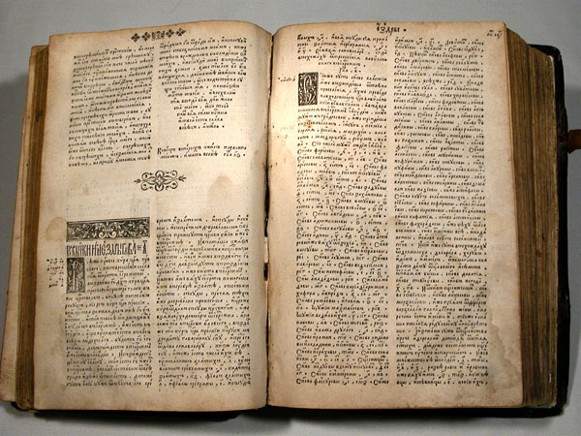Printing
Printing [друкарство; drukarstvo]. The earliest books printed in the Ukrainian redaction of Church Slavonic and in the Cyrillic alphabet in general—the Orthodox hymnal Oktoikh (Octoechos) and Chasoslovets’ (Horologion)—were produced in 1491 by Szwajpolt Fiol, a Franconian expatriate in Cracow. These were followed by liturgical books produced in the Lithuanian-Ruthenian state by short-lived presses on Belarusian territory, such as Frantsisk Skoryna's in Vilno (now Vilnius in Lithuania, 1525), Ivan Fedorovych (Fedorov) and Piotr Mstislavets's in Zabludiv (now Zabłudów in Poland, 1568–70) (see Zabłudów Gospel), and Vasyl Tsiapinsky's itinerant press (ca 1565–70).
The first printing press on Ukrainian ethnic territory was founded by Ivan Fedorovych (Fedorov) in Lviv (1573–4). Its equipment and assets were used to found the Lviv Dormition Brotherhood Press (1591–1788), which played a key role in the history of early Ukrainian printing. Thereafter Lviv remained a major printing center. Established there were Polish (1592–1602, 1670–3, 1684–93), Calvinist (1608–11), and Armenian (1616–18) presses; Cyrillic presses owned by Y. Sheliha (1618–20, 1626–36), Mykhailo Slozka (1638–67), Bishop Arsenii Zhelyborsky (1644–6), and Bishop Yosyf Shumliansky at Saint George's Cathedral (1687–8); a press at the Polish Jesuit college (1642–1773); and the Polish presses of P. Golczewski (1735–51), Ivan Fylypovych (1753–67), and the Szlichtyn family (1755–85). Under Austrian rule the Piller family press (1772 to 19th century) printed books in Latin, Gothic, Hebrew, Greek, and Cyrillic. Other early Cyrillic presses in Galicia were Bishop Hedeon Balaban's Striatyn Press (1602–6), his press in Krylos (1605–6), Y. Sheliha's press in Dobromyl (1611–17), Pavlo Liutkovych-Telytsia's press in Uhortsi (1617–21), and the Univ Monastery press (1648–1770), founded by Bishop Zhelyborsky. A Jewish press founded by U. Foebus Halewy operated in Zhovkva (1693–1782); smaller ones existed in Sambir and Turka.
Printing in Volhynia began after Ivan Fedorovych (Fedorov) entered the service of Prince Kostiantyn Vasyl Ostrozky and founded in Ostroh what became the important Ostroh Press (1577–1612). Other Cyrillic presses were founded by Prince Ostrozky at the Derman Monastery (1602–5); by Kyrylo Stavrovetsky-Tranquillon in Rokhmaniv (1618–19); by Pavlo Liutkovych-Telytsia in Chetvertnia (1624–5), Lutsk (1625–8), and Chorna (1629); and at the Epiphany Monastery in Kremenets (1637–8). Later the important Pochaiv Monastery Press (1730–1918) was founded.
In Right-Bank Ukraine the Polish Protestant Panivtsi Press (1608–11) functioned briefly in Podilia. In Kyiv, printing began with the founding of the Kyivan Cave Monastery Press (1615–1918). It remained the largest printing press in Ukraine until the mid-19th century. Other presses in Kyiv were founded by Tymofii Verbytsky (1624–8) and S. Sobol (1628–31). In 1787 a printing press was founded at the Kyivan Mohyla Academy; later it became the press of the Kyiv Theological Academy.
In Left-Bank Ukraine the first printing presses were those of Kyrylo Stavrovetsky-Tranquillon in Chernihiv(1646) and Archbishop Lazar Baranovych in Novhorod-Siverskyi (1674–9) (see Novhorod-Siverskyi Press), which was moved to Chernihiv and became the important Chernihiv Press (it was later housed, until 1785, at the Trinity–Saint Elijah's Monastery).
In 1720 Tsar Peter I subordinated the presses in Kyiv and Chernihiv to the Russian Orthodox church and forbade the printing of all but church books sanctioned by church censors in Saint Petersburg. From 1721 all books printed in Ukraine were strictly controlled and censored by the Holy Synod, and all Ukrainianisms were consequently banned in imprints of liturgical texts. Secular printeries founded in the second half of the 18th century printed mostly tsarist decrees and government instructions and Russian books of minor importance. Under tsarist rule a Polish-Russian press operated at the Carmelite monastery in Berdychiv (1760–1840). Gubernial government presses were founded in Kremenchuk (1765, 1788–9, 1791), Zhytomyr (1783–1918), Katerynoslav (1793–1918), Kharkiv (1793–1918), Chernihiv (1797–1918), Mykolaiv (1797–1918), Kamianets-Podilskyi (1798–1918), Kyiv (1799–1918), and, in 1807, all other gubernial capitals. Jewish presses were founded in several Volhynian and Podilian towns, and Polish presses existed in Yaryshiv (1790–2), Minkivtsi (1792–1829), Mohyliv-Podilskyi (1797), Yaniv (1812–20), and Kamianets-Podilskyi (1811–49) in Podilia.
In the early 19th century, metal and mechanical printing was introduced into Ukraine, and the modern printing industry evolved there. The Museum of the Book and Printing of Ukraine was established in Kyiv in 1972 and the Museum of Book Printing was opened in Lviv in 1977.
BIBLIOGRAPHY
Ohiienko, I. Istoriia ukraïns’koho drukarstva: Istorychno-bibliohrafichnyi ohliad ukraïns’koho drukarstva XV–XVIII vv. (Lviv 1925; Winnipeg 1983)
Popov, P. (ed). Knyha i drukarstvo na Ukraïni (Kyiv 1965)
Zapasko, Ia.; Isaievych, Ia. Pam’iatky knyzhkovoho mystetstva: Kataloh starodrukiv, vydanykh na Ukraïni, 3 vols (Lviv 1981, 1984)
Zimmer, S. The Beginning of Cyrillic Printing, Cracow, 1491: From the Orthodox Past in Poland (New York 1983)
Yaroslav Isaievych, Roman Senkus
[This article originally appeared in the Encyclopedia of Ukraine, vol. 4 (1993).]

.jpg)
.jpg)
.jpg)